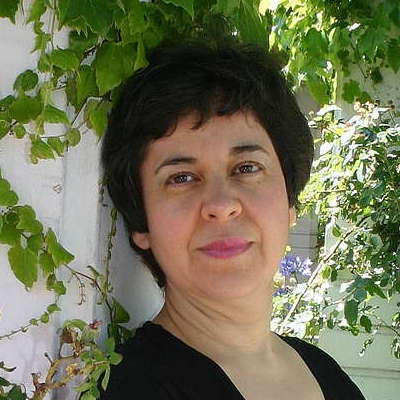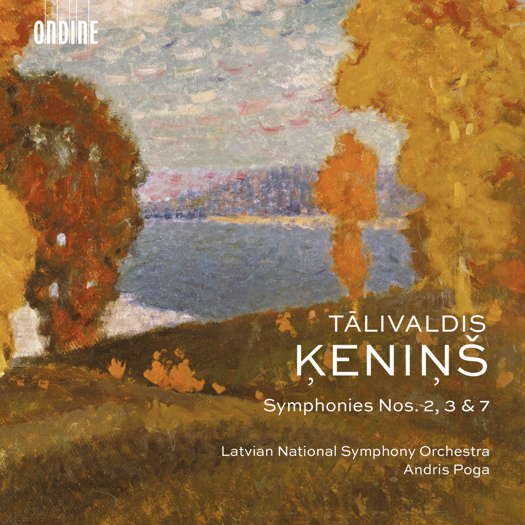 MET STARS: From 2002 until 2021 the late Maria Nockin reported from Arizona, mostly on live opera productions.
MET STARS: From 2002 until 2021 the late Maria Nockin reported from Arizona, mostly on live opera productions.
- Elliott Cook Carter Jr
- Elgar: Cello Concerto
- Concertgebouw Orchestra
- Larry Sitsky
- trumpet music
- Alexei Vladimirovich Stanchinsky
- Adolf Mišek
- Cecilia McDowall: Century Dances
 SPONSORED: A Seasoned Champion of New Music. Argentinian-American pianist Mirian Conti in conversation with Andrew Schartmann.
SPONSORED: A Seasoned Champion of New Music. Argentinian-American pianist Mirian Conti in conversation with Andrew Schartmann.
All sponsored features >>

Wonderfully Transparent and Detailed
ROBERT McCARNEY listens to symphonies by Latvian/Canadian composer Tālivaldis Ķeniņš
'The playing by all concerned is excellent.'
It is exasperating that when so much, and so much great, music is still awaiting a first recording so many record companies continue to release new recordings of the same works by the same composers for the umpteenth time and what's worse continue to repackage and resell recordings that have already seen the light of the day a dozen times or more before. In such a prevailing climate any record company that gives us the chance to hear music that has rarely, or never, been recorded before is only to be applauded and rewarded.
Such is the case with this CD, the fourth and final edition in Ondine's complete cycle of the symphonies of Tālivaldis Ķeniņš. I do not know if they intend to continue to release more of his orchestral works and concertos but with this disc his eight symphonies have now all been recorded. To the best of my knowledge, until Ondine did the decent thing, only one of Ķeniņš' symphonies - his fourth - had ever been previously recorded. It is therefore surprising not to see any claims for world premiere recordings anywhere on this CD.
Living anywhere in between Germany and The Soviet Union for the first half of the twentieth century meant being at the mercy of realpolitik to an extremely harrowing degree as these two states fought their back and forth tug-o-war using any territory in between as their playground and punchbag. Such was the reality for Latvia where Ķeniņš was born in 1919 and from where he finally fled in 1944. He spent five years in Paris before he took up a position as organist in Toronto's St Andrew's church which catered to the city's Latvian Lutheran congregation.
With all these upheavals it is perhaps not so surprising that he came late to the symphony. He composed his first which he considered a dipping of his compositional toes into symphonic waters only when he was forty years old and he was almost fifty when he completed his second in 1968. The Second Symphony is almost a concerto grosso featuring as it does a concertante role for flute, oboe and clarinet. The first movement is busy, bright and breezy.
Listen — Tālivaldis Ķeniņš: I (Symphony No 2)
(ODE 1401-2 track 1, 0:00-0:49) ℗ 2022 Ondine Oy :
There is wonderful interplay between the three soloists as they pass melodies around like a baton between runners in a relay race. All of a sudden it comes to a halt as if the composer has decided that's enough of that. The middle movement (twice as long as the outer movements combined) starts off slowly with a plaintive oboe melody. A lullaby from Canada's indigenous Mi'kmaq people. The melody is subjected to a series of variations at different tempi which give ample evidence of the composer's mastery of contrapuntal craft and orchestration, with especially notable touches from the percussion section. In case the second movement had lulled you into a sense of drowsy numbness the opening of the closing movement is like a bucket of cold water thrown in your face. It has even more bustle that the opening movement. A real showpiece for the entire orchestra which brings this charming, if somewhat lightweight, symphony to a close. I was reminded of Carl Nielsen or maybe Vagn Holmboe throughout.
His Third Symphony, which in an interview he described as 'an essential stepping stone', was written in his fiftieth year and is an all together weightier proposition. The first movement is a rich tapestry made of multiple threads that demonstrates Ķeniņš' polyphonic proficiency. All the varying themes create a texture of searching harmonies. Similar to the first movement of the Second Symphony when it finally seems to be getting somewhere, it peters out. From this, one is led to believe that Ķeniņš was not a man to beat about the bush or one for repeating himself. Once he has said what he has to say, he brusquely and briskly moves on. I like that.
Listen — Tālivaldis Ķeniņš: I (Symphony No 3)
(ODE 1401-2 track 4, 4:10-4:54) ℗ 2022 Ondine Oy :
The searching character continues in the longer central movement as if he very cleverly turns the search for symphonic form into the very form of this symphony. The last movement starts out as if it is in no doubt as to where it is going. The hesitant uncertainty returns for a while before the work closes in a confident climax.
The Seventh Symphony is an intense mostly brooding autobiographical affair, that finishes with a very Mahlerian movement that includes the addition of a mezzo soprano.
Listen — Tālivaldis Ķeniņš: Aria (Symphony No 7)
(ODE 1401-2 track 10, 12:00-12:57) ℗ 2022 Ondine Oy :
The composer's father Atis was a very important political and cultural figure in the birth of modern Latvia and his son chose to set one of his poems to close out this, the most programmatic and probably personal of his symphonies.
Accept within yourself, O soul,
A vast and perfect peace,
Let these threads of starlight
Weave their love 'round you!
These are the closing words of the symphony but the music does not offer the kind of happy acceptance that the verse would seem to suggest. It ends in peace yes but a far from perfect one to my ears anyway. It seems to be a very uncertain disquieting hard won peace reminiscent of the denouement of Shostakovich's Fourth Symphony.
I can imagine that many listeners may prefer this work out of the three on offer on this disc but for me the best of Ķeniņš' is to be found in his Third Symphony. There are those who write symphonies and there are symphonists. For me this Latvian/Canadian composer is the latter. In that sense like all symphonists, all his symphonies are like one work with eight movements which is why Ondine are to be thanked again for giving us the chance to hear the whole cycle. For those new to this composer maybe the CD that includes his Fourth and Sixth Symphonies is the best introduction but this present disc also fits the bill very well. The playing by all concerned is excellent. I was especially impressed by the contribution of Zanda Švēde, above all by the incredible round burnished tone she has in her very lowest register. The recording couldn't be better. For a composer for whom counterpoint was such a central part of his craft being able to hear all the detail in his various lines is essential, which is the case in this wonderfully transparent and detailed recording.
The liner notes are good, although they could be better. There are a couple of misprints regarding dates of composition and they are in English only.
In his analysis, Georgs Pelēcis writes: "In fact, the passacaglia determines the form at two levels. Over the course of the work, the main theme is continuously heard (not including separate intonations, a fuller count of the exposition is 19), and one of the movements (the second) is a passacaglia in both name as well as in the development principle."
Paragraphs like this above do not aid understanding and I can only hope that:
"The symphony's steel waves, constantly rising anew and tormenting our memories, stormily envelop us." He also indicates that "how masterfully the rigid Atis Ķeniņš poem verse is 'dismantled' in the vocal part by the soulful asymmetries."
reads a lot better in Latvian than it does in English where frankly it is gibberish. The art work, as is invariably the case with Ondine, is beautifully apposite and atmospheric, as it has been with the other three CDs in this series. In this case it features an impressionistic autumn scene by Vilhelms Purvītis. All in all, an excellent conclusion to a much needed and enjoyed series.
Copyright © 14 September 2022
Robert McCarney,
León, Spain

CD INFORMATION - TĀLIVALDIS ĶENIŅŠ: SYMPHONIES NOS 2, 3 & 7
CLASSICAL MUSIC ARTICLES ABOUT LATVIA
CLASSICAL MUSIC ARTICLES ABOUT CANADA


